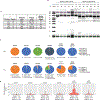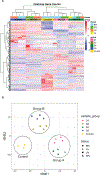Molecular characterization stratifies VQ myeloma cells into two clusters with distinct risk signatures and drug responses
- PMID: 37031341
- PMCID: PMC10367583
- DOI: 10.1038/s41388-023-02684-9
Molecular characterization stratifies VQ myeloma cells into two clusters with distinct risk signatures and drug responses
Abstract
Multiple myeloma (MM) is a cancer of malignant plasma cells in the bone marrow and extramedullary sites. We previously characterized a VQ model for human high-risk MM. The various VQ lines display different disease phenotypes and survival rates, suggesting significant intra-model variation. Here, we use whole-exome sequencing and copy number variation (CNV) analysis coupled with RNA-Seq to stratify the VQ lines into corresponding clusters: Group A cells had monosomy chromosome (chr) 5 and overexpressed genes and pathways associated with sensitivity to bortezomib (Btz) treatment in human MM patients. By contrast, Group B VQ cells carried recurrent amplification (Amp) of chr3 and displayed high-risk MM features, including downregulation of Fam46c, upregulation of cancer growth pathways associated with functional high-risk MM, and expression of Amp1q and high-risk UAMS-70 and EMC-92 gene signatures. Consistently, in sharp contrast to Group A VQ cells that showed short-term response to Btz, Group B VQ cells were de novo resistant to Btz in vivo. Our study highlights Group B VQ lines as highly representative of the human MM subset with ultrahigh risk.
© 2023. The Author(s), under exclusive licence to Springer Nature Limited.
Conflict of interest statement
Competing Interests statement:
We declare that no conflict of interest exists.
Competing Interests Statement:
We declare no competing financial interests.
Figures







Similar articles
-
Exosomal mRNAs and lncRNAs involved in multiple myeloma resistance to bortezomib.Cell Biol Int. 2021 May;45(5):965-975. doi: 10.1002/cbin.11540. Epub 2021 Jan 15. Cell Biol Int. 2021. PMID: 33372728 Free PMC article.
-
CircRNA ITCH increases bortezomib sensitivity through regulating the miR-615-3p/PRKCD axis in multiple myeloma.Life Sci. 2020 Dec 1;262:118506. doi: 10.1016/j.lfs.2020.118506. Epub 2020 Oct 5. Life Sci. 2020. PMID: 33031827
-
Upregulated expression and function of the α4β1 integrin in multiple myeloma cells resistant to bortezomib.J Pathol. 2020 Sep;252(1):29-40. doi: 10.1002/path.5480. Epub 2020 Jul 22. J Pathol. 2020. PMID: 32501543
-
hsa-miR-631 resensitizes bortezomib-resistant multiple myeloma cell lines by inhibiting UbcH10.Oncol Rep. 2017 Feb;37(2):961-968. doi: 10.3892/or.2016.5318. Epub 2016 Dec 14. Oncol Rep. 2017. PMID: 28000886
-
Resistance to the Proteasome Inhibitors: Lessons from Multiple Myeloma and Mantle Cell Lymphoma.Adv Exp Med Biol. 2020;1233:153-174. doi: 10.1007/978-3-030-38266-7_6. Adv Exp Med Biol. 2020. PMID: 32274756 Review.
Cited by
-
Dissecting the Puzzling Roles of FAM46C: A Multifaceted Pan-Cancer Tumour Suppressor with Increasing Clinical Relevance.Cancers (Basel). 2024 Apr 27;16(9):1706. doi: 10.3390/cancers16091706. Cancers (Basel). 2024. PMID: 38730656 Free PMC article. Review.
-
Immunocompetent mouse models of multiple myeloma.Semin Hematol. 2025 Feb;62(1):50-57. doi: 10.1053/j.seminhematol.2024.11.003. Epub 2024 Nov 16. Semin Hematol. 2025. PMID: 39674742 Review.
-
Modulation of Autophagy by Oncosuppressor FAM46C and Its Implications for Cancer Therapy: An Intriguing Perspective.Biomolecules. 2025 Jan 30;15(2):196. doi: 10.3390/biom15020196. Biomolecules. 2025. PMID: 40001499 Free PMC article. Review.
References
-
- Palumbo A, Anderson K. Multiple myeloma. N Engl J Med 2011; 364: 1046–1060. - PubMed
-
- Walker BA, Wardell CP, Chiecchio L, Smith EM, Boyd KD, Neri A et al. Aberrant global methylation patterns affect the molecular pathogenesis and prognosis of multiple myeloma. Blood 2011; 117: 553–562. - PubMed
-
- Caro J, Al Hadidi S, Usmani S, Yee AJ, Raje N, Davies FE. How to Treat High-Risk Myeloma at Diagnosis and Relapse. Am Soc Clin Oncol Educ Book 2021; 41: 291–309. - PubMed
-
- Mikhael JR, Dingli D, Roy V, Reeder CB, Buadi FK, Hayman SR et al. Management of newly diagnosed symptomatic multiple myeloma: updated Mayo Stratification of Myeloma and Risk-Adapted Therapy (mSMART) consensus guidelines 2013. Mayo Clin Proc 2013; 88: 360–376. - PubMed
Publication types
MeSH terms
Substances
Grants and funding
LinkOut - more resources
Full Text Sources
Medical
Molecular Biology Databases

